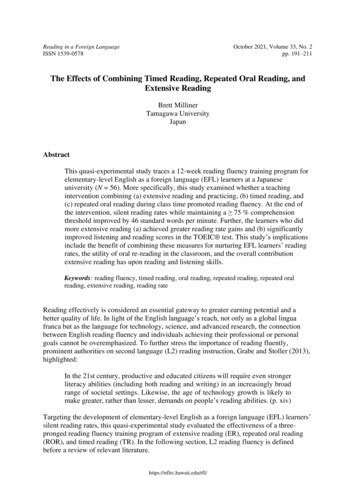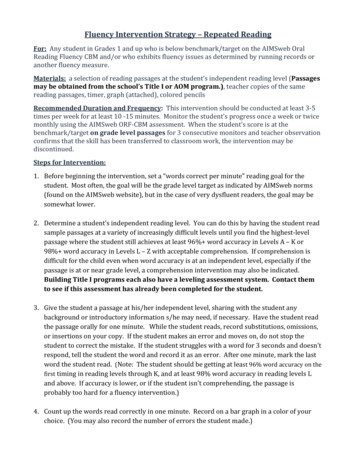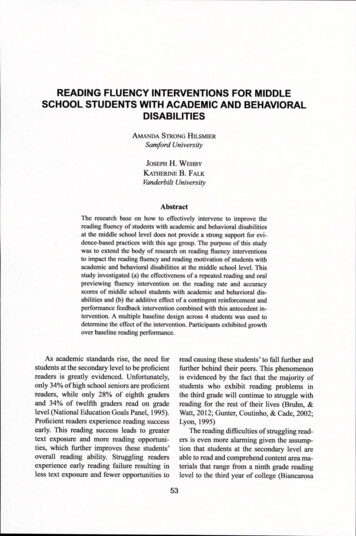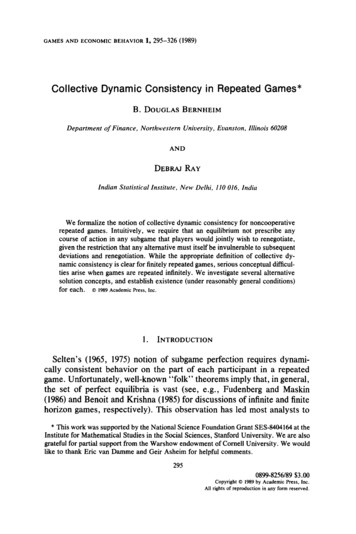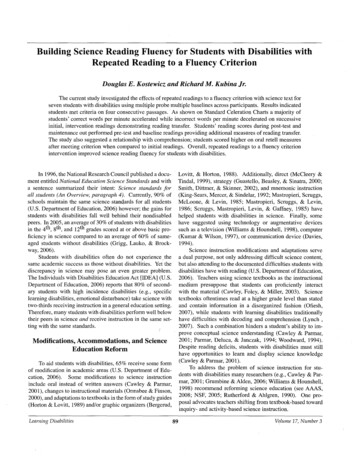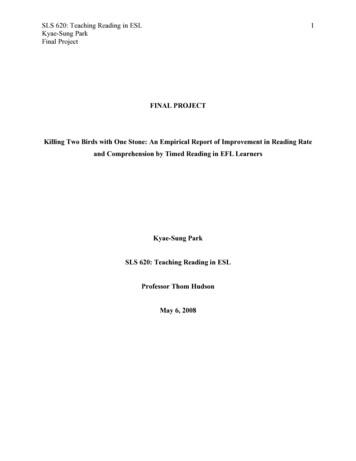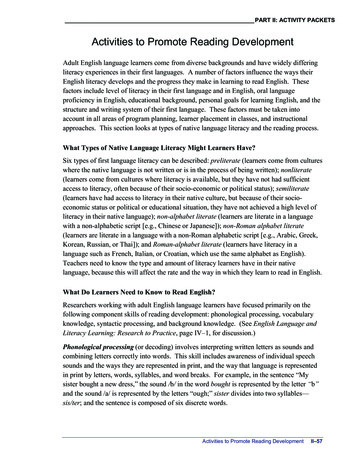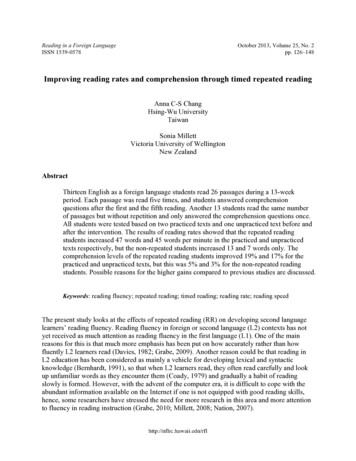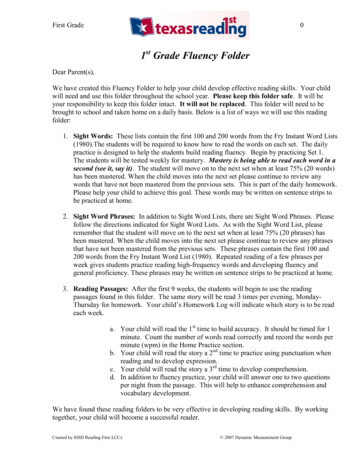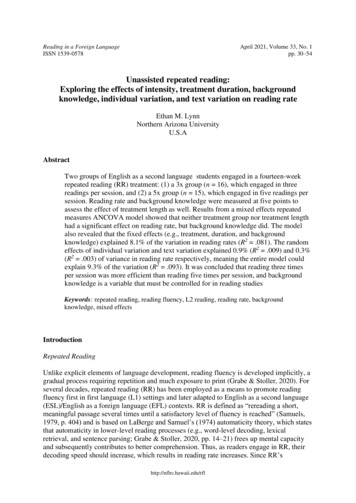
Transcription
Reading in a Foreign LanguageISSN 1539-0578April 2021, Volume 33, No. 1pp. 30–54Unassisted repeated reading:Exploring the effects of intensity, treatment duration, backgroundknowledge, individual variation, and text variation on reading rateEthan M. LynnNorthern Arizona UniversityU.S.AAbstractTwo groups of English as a second language students engaged in a fourteen-weekrepeated reading (RR) treatment: (1) a 3x group (n 16), which engaged in threereadings per session, and (2) a 5x group (n 15), which engaged in five readings persession. Reading rate and background knowledge were measured at five points toassess the effect of treatment length as well. Results from a mixed effects repeatedmeasures ANCOVA model showed that neither treatment group nor treatment lengthhad a significant effect on reading rate, but background knowledge did. The modelalso revealed that the fixed effects (e.g., treatment, duration, and backgroundknowledge) explained 8.1% of the variation in reading rates (R2 .081). The randomeffects of individual variation and text variation explained 0.9% (R2 .009) and 0.3%(R2 .003) of variance in reading rate respectively, meaning the entire model couldexplain 9.3% of the variation (R2 .093). It was concluded that reading three timesper session was more efficient than reading five times per session, and backgroundknowledge is a variable that must be controlled for in reading studiesKeywords: repeated reading, reading fluency, L2 reading, reading rate, backgroundknowledge, mixed effectsIntroductionRepeated ReadingUnlike explicit elements of language development, reading fluency is developed implicitly, agradual process requiring repetition and much exposure to print (Grabe & Stoller, 2020). Forseveral decades, repeated reading (RR) has been employed as a means to promote readingfluency first in first language (L1) settings and later adapted to English as a second language(ESL)/English as a foreign language (EFL) contexts. RR is defined as “rereading a short,meaningful passage several times until a satisfactory level of fluency is reached” (Samuels,1979, p. 404) and is based on LaBerge and Samuel’s (1974) automaticity theory, which statesthat automaticity in lower-level reading processes (e.g., word-level decoding, lexicalretrieval, and sentence parsing; Grabe & Stoller, 2020, pp. 14–21) frees up mental capacityand subsequently contributes to better comprehension. Thus, as readers engage in RR, theirdecoding speed should increase, which results in reading rate increases. Since RR’shttp://nflrc.hawaii.edu/rfl
Lynn: Unassisted Repeated Reading31inception, two major methods to implement it have been developed: assisted and unassistedRR. Assisted RR entails the listening of a text read orally (either through live readings orrecorded readings) while unassisted repeated reading omits the listening to texts being readand rather consists of individual reading of text, which can be done orally and/or silently.RR’s effectiveness in developing reading fluency has been studied in English L1 contextsamong school-age children. Specifically, RR has been shown to increase reading rate (Carver& Hoffman, 1981; Dowhower, 1987; Herman, 1985; Kuhn, 2005; Rasinski, 1990; Rashotte& Torgesen, 1985). Gains in reading rate can be transferred to unpracticed texts (Dowhower,1987; Herman, 1985; Rashotte & Torgesen, 1985). For example, Dowhower (1987) reportedthat second graders increased their oral reading rate by over 75% in both assisted andunassisted treatments. Similarly, Rasinski (1990) found that third graders improved their oralreading rate by 20% in a short, assisted RR intervention and by 25% in a short, unassisted RRintervention. Thus, it can be concluded that RR is indeed a beneficial approach in developingreading fluency of children in English L1 contexts.The effect of RR on reading rate in ESL/EFL settings has received some attention but stillremains a relatively unexplored area (see Taguchi et al., 2006). In post-secondary EFLcontexts, it has been shown that oral repeated reading can lead to increased reading rate(Chang, 2012; Shimono, 2018). Other studies in the same setting have investigated the effectsof silent RR on reading rate with some mixed results (Taguchi, 1997; Taguchi & Gorsuch,2012; Taguchi et al., 2004; Gorsuch & Taguchi, 2008; Chang & Millett, 2013). However, theeffect of RR on reading rate development in ESL contexts has not received any attention asthe research has focused primarily on children’s language development (see Blum et al.,1995; Koskinen et al., 2000; Quiroga et al., 2002). As an extension of the existing postsecondary EFL RR research, the current study specifically investigated the impact ofunassisted RR on reading rate in a post-secondary ESL setting.In the previous post-secondary EFL RR studies, two variables related to reading rate have notbeen explored: (1) intensity, the number readings per RR session and (2) duration oftreatment, the length of a RR intervention. There is anecdotal evidence suggesting that toomany readings can be counterproductive, due to resultant participant boredom,disengagement, discouragement, and demotivation (Chang & Millett, 2013, p. 140; Taguchiet al., 2012, p. 48; Taguchi et al., 2016, pp. 110–111). Regarding treatment duration, somehave suggested that post-secondary ESL/EFL fluency programs lasting an entire semesterwill also result in boredom and a sense of drudgery (Millett, 2008, p. 25). Thus, the currentstudy had two objectives pertaining to the development of reading rate: (1) to compare twoRR treatments with varying degrees of intensity (e.g., five reading per session compared tothree) and (2) to investigate empirically the effect of RR treatment length.In addition to intensity and duration, the impact of background knowledge, individualvariation, and text variation have not been accounted for in post-secondary ESL/EFL RRstudies despite their noted impact on reading generally for English language learners (ELL)(Shin et al., 2019; Anderson, 1991; Laufer & Ravenhorst-Kalovski, 2010). Therefore, thecurrent study also included a third objective: (3) to assess empirically the effect ofbackground knowledge, individual variation, and text variation on reading rate. The resultsfrom such an investigation can be used to (a) improve ESL/EFL reading fluency instructionby optimizing such activities so maximum gains can be realized and (b) better elucidate theimpact of potentially intervening variables on reading rate.Reading in a Foreign Language 33(1)
Lynn: Unassisted Repeated Reading32Repeated Reading and Reading RateTaguchi and his colleagues (Taguchi, 1997; Taguchi & Gorsuch, 2002; Taguchi et al., 2004;Gorsuch & Taguchi, 2008) conducted four RR studies in post-secondary EFL settings, whichinvestigated the effect of a combination of assisted and silent unassisted RR on reading rateand comprehension (see Table 1). Because the focus of the current study was on reading rate,results pertaining to comprehension are not reported. These studies produced mixed resultsfor within group comparisons from pre-test to post-test: In some cases, reading rate increasedafter the RR treatment (Taguchi, 1997; Taguchi & Gorsuch, 2002; Gorsuch & Taguchi, 2008)whereas reading rates decreased in other cases (Taguchi et al., 2004; Gorsuch & Taguchi,2008). For example, the largest rate gain was in the 2002 study ( 40 wpm, d 1.33), and thelargest rate decrease was in the 2008 study (-18 wpm, d -0.49). Thus, the evidence reportedin these initial studies is not conclusive, resulting in the need for further examination of theimpact of RR on reading rate.Table 1Summary of Previous Post-Secondary EFL RR aguchi (1997)731030210 201.19Taguchi &5ca. 31028196 401.33Gorsuch (2002)Taguchi et al.52–31742210-3-0.14(2004)Gorsuch &521122110 200.53Taguchi (2008)-18-0.49Chang & Millett521326130 471.58(2013) 451.55Note. Gains and their corresponding Cohen’s d values were for within group comparisons.Guided by these four foundational studies, Chang and Millett (2013) conducted an additionalRR study in a post-secondary EFL environment using silent unassisted RR (refer to Table 1).They argued that some of the unfavorable results found in previous studies stemmed frominequality of text difficulty and the use of narrative texts. That is, text difficulty was notsymmetrical between treatment texts and testing texts, nor was it symmetrical between pretests and post-tests. Therefore, they employed texts that were intentionally designed forfluency development: texts that were discrete and controlled for passage length, vocabulary,and grammar. Such texts had been used previously in studies investigating timed reading,also referred to as speed reading, with increases in reading rate being reported (see Chung &Nation, 2006; Macalister, 2008, 2010). Essentially, Chang and Millet (2013) adapted themethodology of timed reading to create their RR intervention. That is, instead of readingpassages only one time as done in timed reading, participants in their study read passages fivetimes. Within group results showed that participants in the RR treatment group improvedtheir reading rate by 47 words per minute (d 1.58) on practiced texts and 45 words perminute on unpracticed texts (d 1.55). The RR group also outgained a control group by 34words per minute and 38 words per minute on practiced texts and unpracticed textsrespectively. These results demonstrate that controlling for text type, passage length,vocabulary, and grammar can reduce noise and potentially lead to reading rate gains.Reading in a Foreign Language 33(1)
Lynn: Unassisted Repeated Reading33Intensity and DurationWhile previous post-secondary EFL RR studies have mostly demonstrated positive results inregard to reading rate gains, two principal aspects remain relatively unexplored and requirefurther attention. The first variable requiring more attention is intensity—the number ofreadings per RR session. Two studies have investigated the impact of the number of readingsfor within group comparisons. For example, Stoddard et al. (1993) found that for English L1underperforming readers in the fourth and fifth grades, reading rate increased from threereadings to seven within a single RR session. In Taguchi’s (1997) post-secondary EFL study,participants’ silent reading rates increased from the first to fifth readings and from the fifth toseventh readings in a single session. These results indicate that more readings per session canlead to gains in reading rate. It is important to note that these studies investigated intensity ina single session, not the effect of intensity over the course of an entire treatment. In contrastto the findings from Stoddard et al. (1993) and Taguchi (1997), it has been noted that RRtreatments with too many readings per session over the course of an entire treatment—tomuch intensity—can be boring, disengaging, discouraging, and demotivating, which canresult in adverse effects. (Chang & Millett, 2013, p. 140; Taguchi et al., 2012, p. 48; Taguchiet al., 2016, pp. 110-111). While three to five readings have been recommended as optimal(Nation, 2009a, p. 136), this claim has yet to be tested empirically over the course of an entireRR treatment period.The second variable requiring further investigation is duration of treatment—the length of aRR treatment. Millett (2008) cautioned teachers to do fluency-developing activities for thefirst few weeks of the semester to avoid “[dragging] the programme out for the course oftwelve weeks until everyone is thoroughly bored with it” (p. 25). There is some evidence tosupport the effectiveness of a shorter RR treatment. For example, Rasinski (1990) found thatthird graders whose L1 was English were able to improve their oral reading speed after justtwo days of treatment. Chung and Nation (2006) reported that in a semester-long timedreading treatment in a post-secondary EFL context, most of the increase in reading rates wasrealized in the first half although gains were still made in the second half of the semester. Onthe other hand, there is evidence indicating that a longer treatment may yield better resultsthan a shorter treatment. For example, Hollingsworth (1970) found that a RR treatment of 32sessions did not yield reading rate gains, but his follow up study (Hollingsworth, 1978),which featured 62 sessions, did result in gains. One explanation for such a dramaticdifference between studies was that the first study’s participants were at-level readers whilethe participants in the second study were below-level readers. Overall, an investigation oftreatment intensity and duration could help improve RR interventions by leading to moreefficient and effective implementation.Background Knowledge, Participant Variation, and Text VariationIn addition to intensity and duration, three additional variables can impact reading rate:background knowledge, individual variation, and text variation. Pertaining to backgroundknowledge, Birkmire (1985) found that reading rate depended on a reader’s backgroundknowledge, with more topic familiarity leading to faster reading rates. Corroboratingevidence has been furnished in subsequent studies as well (see Shimoda, 1993; Priebe et al,2012). In relation to individual variation, eye tracking data has been used to show individualdifferences in reading speed: individual readers vary in the amount of time to decode wordsand comprehend full sentences, which contributes to variations in reading rate (Rayner et al.,2015; Staub & Benatar, 2013). Such individual differences can be explained by three factors:Reading in a Foreign Language 33(1)
Lynn: Unassisted Repeated Reading34individual differences in (1) the amount of time needed to access long-term memory in worddecoding (Jackson, 1980), (2) reading skill (e.g., average skilled vs. highly skilled; Ashby etal, 2006), and (3) that fact that topic interest can contribute to faster reading rates (Shimoda,1993). Additionally, the impact of textual variation was demonstrated by Birkmire (1980),who reported that the location of information in the text structure affected reading rate. Wordfrequency also affects the length of duration as evidenced by short fixations on highfrequency words as compared to low frequency words (Inhoff & Rayner, 1986). In fact, thereis evidence to indicate an interaction effect between reading ability and textual factors(Ashby et al., 2005). Although there is ample evidence demonstrating the impact that thesevariables can have on reading rate in English L1 settings, it remains unknown how theyimpact non-L1 reading—specifically in a RR treatment in an ESL setting.Rationale & Research QuestionsRepeated reading has been the means of promoting reading fluency for several decades,particularly in English L1 settings. The handful of post-secondary EFL RR studies haveproduced somewhat conflicting results: RR interventions resulted in improved reading ratesin some instances while resulting in decreased reading rate in others. Despite these findings,there has yet to be a post-secondary ESL RR study. Reading rate in a RR treatment could bemediated by variables inherent in the setting: the quantity and quality of language inputgenerally; quality of instruction, especially in the reading classroom; and certain affectivevariables. This merits specific investigation of a RR treatment in an ESL context. It has alsobeen demonstrated that the variables of intensity and treatment duration could influence theeffectiveness of RR, but those variables have not yet been measured empirically. Backgroundknowledge, individual variation, and text variation have been shown to impact reading rateand are logical variables to investigate in a RR treatment. The current study, therefore,intended to answer the following research questions:1. To what extent does the intensity of an unassisted RR treatment affect reading rates?2. To what extent does the duration of an unassisted RR treatment affect reading rates?3. To what extent do background knowledge, individual variation, and text variationaffect reading rates in an unassisted RR treatment?MethodParticipantsThe participants in the study were 31 international students in their first semester of study at aregional university’s intensive English program in the southwest United States, selected froman original pool of 34 students. Three students were excluded from the study for thefollowing reasons: not consenting, missing the post-test, and failing to follow instructions.The native language of these participants was almost exclusively Mandarin Chinese (n 30)with a single native speaker of Japanese (n 1). Prior to the study, the number of yearsstudents had been studying English varied: over ten (n 16), ten (n 9), nine (n 3), seven(n 2), and six (n 1). Intended student majors were as follows: creative media and film (n 16), computer science (n 5), hotel management (n 3), engineering (n 2), biology (n 1),Reading in a Foreign Language 33(1)
Lynn: Unassisted Repeated Reading35criminal justice (n 1), criminology (n 1), finance (n 1), and forestry (n 1). Theaverage age of the participants was 19.6 years old with a range from 18 to 24.After taking a placement test at the beginning of the term, students were placed in theprogram’s fourth level, which corresponded to a TOEFL score range of 45 to 56 and anIELTS score range of 5 to 5.5. Students in this fourth level were placed into one of twosections as assigned by the institution. Participants were enrolled in 20 hours of intensiveEnglish instruction per week, which entailed the following classes: listening and speaking(six hours/week), content-based instruction class (six hours/week), reading and vocabulary(four hours/week), and writing and grammar (four hours/week).Materials and InstrumentsThe reading materials used for this study came from digital books from Sonia Millett’suniversity webpage, as recommended by Chang and Millett (2013, p. 142), because they werecontrolled for length, vocabulary, and grammar (see Appendix A). The vocabulary in thesepassages was controlled at the 2K BNC headword level, meaning passages were comprised ofthe 2,000 most frequently occurring headwords from the BNC. Each passage wasapproximately 400 words in length. Each book also claimed that the grammatical difficultywas controlled through the limited use of relative clauses, passive verb constructions, anddifficult time references. Each text came with an accompanying set of ten multiple-choicequestions aimed at global comprehension (e.g., the topic, main idea, and major details). Eachcomprehension question contained three answer options (See Appendix A for a link to thepassages and comprehension questions). While comprehension was not the focus of thecurrent study, the questions served to strengthen the validity of the readings because it heldparticipants accountable to do the reading carefully. That is, because participants knew theywere required to answer comprehension questions after reading, they read the texts carefullyrather than reading superficially (e.g., skimming) to achieve a faster rate. The questions wereinformed by Nation’s (2009b) recommendations for fluency-focused activities in that theyfocused on global understanding of main ideas and major details. The inclusion ofcomprehension questions in the current study is similar to inclusion of comprehension checksin self-paced reading research. A brief analysis of comprehension scores (see Appendix B)showed that participants were reading for meaning. However, no major conclusions should bedrawn from those results because the questions were not necessarily designed to be a reliablemeasure of comprehension. In total, 24 texts were used in the study: one for practice,eighteen for the treatment, and five for data collection.Data CollectionParticipants’ reading rates and background knowledge were measured at five testingcheckpoints, which lasted between ten to fifteen minutes each. At each testing checkpoint,participants timed themselves while reading a given text and recorded the number of minutesand seconds taken to read the text on a Google Form distributed by the instructor to thestudents through email. To measure the time taken to read the pre-test passage, a digitalstopwatch was displayed, and students recorded their time upon completing the reading. Atsubsequent testing checkpoints, the participants timed themselves using the stopwatch featureon their individual phones because this was the way in which they timed themselves duringtreatment texts. The time taken to read each passage was converted to words per minute. Onthe same Google Form, participants answered the ten multiple-choice comprehensionquestions accompanying each text without referring to the text. Finally, participants reportedReading in a Foreign Language 33(1)
Lynn: Unassisted Repeated Reading36the level of background knowledge they had prior to reading the text, using a Likert-typescale ranging from one (I knew a little) to six (I knew a lot). All student responses were savedautomatically and compiled in a Google Sheet, which was then downloaded as an ExcelSpreadsheet and converted to a csv file.ProcedureThe activities related to the study were carried out as part of the participants’ reading andvocabulary class, which met two times per week for two hours per class and had the sameinstructor for both sections. RR intervention activities were completed at the beginning ofeach class period for both sections. Students received a completion grade for participating inthe RR activities regardless of whether or not they were included in the study. Theparticipants whose reading and vocabulary class section was labeled Section A (n 15)comprised the treatment group which engaged in five readings per RR session (5x group,hereafter). The participants whose reading and vocabulary class was labeled Section B (n 16) comprised the treatment group which engaged in three readings per RR session (3xgroup, hereafter). Apart from the difference in the number of readings per session betweenthe two sections, classroom instruction, activities, homework, and assessments were parallel.During the first class meeting of week 1, participants engaged in a practice pre-test. Beforeany activities were commenced, instructions were given regarding how to do the pre-test: (1)read the passage silently and quickly without stopping, (2) refrain from underlining andcircling parts of the text, (3) record the time taken to read each passage, (4) answer theaccompanying comprehension questions without referring to the text, and (5) report the levelof background knowledge. At the conclusion of the practice pre-test, the task instructionswere repeated because many students disregarded or did not follow them—especially theinstruction of not referring back to the text when answering comprehension questions. Duringthe second class meeting of week 1, the pre-test was administered to students with the sameinstructions as the practice pre-test.During the first class meeting of week 2, students were given instructions regarding how toengage in the RR treatment. Before the RR treatment, students were given a RR log to recordtheir reading rates and comprehension scores (see Appendix C). Instructions were then given:In step one, both the 3x group and the 5x groups read the passage one time, recorded the timetaken to read, and answered the comprehension questions without referring back to the text.In step two, the 3x group reread the same passage once and recorded their time whereas the5x group reread the passage three times without answering the comprehension questions andrecorded their time for each reading. In the last step, both groups read the passage a finaltime, recorded the time taken to read, answered the comprehension questions withoutreferring back to the text, checked their answers using an answer key written on the board,and recorded the percentage of correctly answered questions. Thus, the 3x group read eachtreatment passage three times while the 5x group read each passage five times. This processwas repeated with a new text for each of the eighteen RR sessions during the semester.Students occasionally missed treatment sessions without making them up. The averagenumber of treatment texts read for the 3x group was 16.9 and 17.5 for the 5x group. Whilethere was some asymmetry in the administration of the treatment, the difference between thegroups was small enough not to be a cause for concern.The treatment procedure lasted for a total of fourteen weeks (see Table D2 in Appendix D). Atypical RR session lasted roughly ten minutes for the 3x group and roughly fifteen minutesReading in a Foreign Language 33(1)
Lynn: Unassisted Repeated Reading37for the 5x group. During the fourteen weeks, there were five testing checkpoints, whichfollowed the same format as the pre-test outlined above: Test 1 (pre-test), Test 2, Test 3, Test4, Test 5 (post-test). At the conclusion of Test 5, participants answered a short questionnaireregarding their perception of the RR treatment (see Appendix D for a link to thequestionnaire). Between the testing checkpoints, participants engaged in five treatmentsessions except for the period of time between Test 4 and the Test 5. In that space of time,participants engaged in only three treatment sessions because a holiday break wasapproaching, which would have created a large gap in the treatment. It is important to notethat between the end of the tenth treatment session and Test 3, there was a one-week gap foran institutional midterm examination and preparation time, during which students did notengage in any RR activities.Data AnalysisParticipants’ responses at each testing checkpoint were downloaded, compiled, and convertedto a csv file. To answer research question one, which was concerned about the impact of RRintensity on rate, the two treatment groups were contrasted based on change in reading ratefrom pre-test to post-test. Means, standard deviations, and 95% mean confidence intervalswere calculated. After an independent t-test was conducted, mean differences, 95% meandifference confidence intervals, effects sizes (Cohen’s d values), and a p values werereported. Cohen’s d values were interpreted using Plonsky and Oswald’s (2014, p. 889)benchmarks: Values of 0.4, 0.70, and 1.00 are roughly considered small, medium, and largerespectively for between group comparisons.To answer the second research question, which addressed the impact of treatment duration onreading rate, means, standard deviations, and 95% mean confidence intervals, effects sizes(Cohen’s d values), and p-values were calculated without dividing the participants intotreatment groups. Thus, reading rates could be compared to another at various points in time.Plonsky and Oswald’s (2014, p. 889) benchmarks for within group comparisons were appliedin these calculations: small, medium, and large labels corresponded to values of 0.60, 1.00,and 1.40 respectively.To examine research questions one and two more fully, the data were also organized by timeand treatment group to make between group comparisons at the various checkpoints and tomake within group comparisons across testing checkpoints. For these calculations, thedifferences in pre-test reading rates between the two groups needed to be controlled for.Therefore, change in reading rate was calculated by subtracting the reading rate at the pre-testfrom the reading rate at each subsequent testing checkpoint. Thus, all change in reading ratefigures were relative to the pre-test.Finally, to answer the third research question, which focused on the impact of backgroundknowledge, individual variation, and text variation, a mixed methods RM-ANCOVA modelwas created. Background knowledge refers to the extent of a participant’s knowledge of thetopic, individual variation refers to the potential variance in reading rate across participants,and text variation refers to the potential variation across the multiple texts used to assess RR.For the model, the fixed effects were treatment group (3x and 5x) and duration (measured atfive testing checkpoints), the covariate was background knowledge, and the random effectswere individual variation and text variation. The dependent variable was reading rate. Anomnibus ANOVA using Sattherwaite’s method was conducted to determine if the fixedeffects, interaction between the fixed effects, and covariate significantly contributed to theReading in a Foreign Language 33(1)
Lynn: Unassisted Repeated Reading38model. The lme4 package in R was used for these calculations (Bates et al., 2015). Amarginal R2 value was calculated to determine the amount of variance that could be explainedby the fixed factors and covariate. A conditional R2 value was also calculated to determinethe amount of variance that could be explained by a combination of the fixed factors and therandom effects. To pinpoint the amount of variance each random effect could explain, theconditional R2 value was subtracted from the marginal R2 value to arrive at the amount ofvariance explained by the random effects combined. Then, each random effect’s proportionof that variance was determined (see Nakagawa & Schielzeth, 2013). For these calculationsthe MuMIn package was used (Barton, 2019).The stats program R (R Core Team, 2019) and RStudio (R Studio Team, 2019) were used fordata analysis. Figures were generated using the ggplot2 package (Wickham, 2016). Beforeany statistical analyses were conducted, statistical assumptions were checked. Because mostdata met all the assumptions, cautiously proceeding with the data analysis was deemed to beacceptable.ResultsThe aims of the current study were to evaluate the effects of intensity, treatment duration,background knowledge, individual variation, and text variatio
That is, instead of reading passages only one time as done in timed reading, participants in their study read passages five times. Within group results showed that participants in the RR treatment group improved their reading rate by 47 words per minute (d 1.58) on practiced texts and 45


